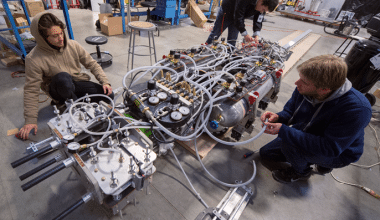It is a career so amazing to want to become an animator where you can have the possibility to give life to images and ideas in numerous fields such as healthcare, education, law, film, television, and gaming.
Animators use computers and animation software to create 2-D and 3-D animation for websites, video, film, and mobile media.
Relax and read on as I take you through a journey to become an animator successfully. This article will answer all your questions as it contains full details on how to become an animator.
Apparently, drawing and sculpting skills still play a role in today’s animation, but cutting-edge technology has combined with art to expand the field. An animator creates an extensive series of images that form the animation seen in movies, commercials, television programs, and video games.
However, you’ll need to be highly artistic and able to turn descriptions and storyboards into compelling visuals.
So, you could be working in a small company or a large animation studio. You may be animating for television, film, or computer games.
Typically, animators specialize in one of these media and may further concentrate on a specific area, such as characters, scenery, or background design.
Furthermore, animators typically use computer software to do their work. They are members of a team of other animators and artists collaborating on projects.
Some animators are self-employed, often working from home, and must always be on the lookout for new freelance assignments.
On the other hand, others are employed full-time by companies and studios. Also, workweeks are often long, and animators sometimes work nights and weekends.
What Is Animation?
Animation is a way of making a movie from many still images. The images are put together one after another and then played quickly to give the illusion of movement.
A movement simulation is created by displaying a series of pictures or frames. Cartoons on television are examples of animation. … Whereas video takes continuous motion and breaks it up into discrete structures, energy starts with independent pictures. and puts them together to form the illusion of constant motion.
Who Is An Animator?
Animators create films for production companies, major animation studios, and computer game companies.
Typical responsibilities include: working creatively to produce original and aesthetically pleasing designs and solutions. Using specialist computer generation software such as Maya, Flash, and After Effects.
Furthermore, An animator is an artist who creates multiple images, known as frames, which give an illusion of movement called animation when displayed in rapid sequence.
Animators can work in various fields, including film, television, and video games.
How Can I Become an Animator?
Aspiring animators typically have numerous sketches and art pieces to prove their passion and talent., but they might not know how to get their foot into the door of an exciting and innovative studio. Amazingly, in the same way, the animation is magical; it’s also mystical.
To help you bring all of your magical ideas to life (and land an excellent job), here are steps to take in other to achieve this:
Step 1. Complete Your Animation Education Requirements
Completing a bachelor’s animation degree program provides students with valuable art skills and teaches them to be proficient in the technology used in this industry. Also, there are many specialties within the animation field, including gaming, visual or special effects, animation for websites, and animation for film, video, or online.
Foundation courses touch on basic animation requirements, such as art, drawing, multimedia, 2-D and 3-D animation, and graphics.
According to the US Bureau of Labor Statistics, multimedia artist and animator positions typically require a bachelor’s degree.
Of course, your animation program should depend on your career goals, prior education, and existing skills. Your options include associate’s and bachelor’s degree programs and non-degree programs like certificate and diploma programs.
Degree programs usually provide a broader education, moving from foundational to advanced courses. While non-degree programs narrow in on specific specialties and may require existing skills or prior knowledge of specific areas.
Whichever way, be sure to choose the right program. Students should choose an animator degree program with courses in the skills required for their chosen specialty.
For instance, interactive animation courses required for gaming may not help the student whose career path is special effects animation for film.
Step 2. Gain Work Experience (Skill development)
Importantly, work experience is a major animator requirement. Irrespective of the goodness of your animation program, your instructors can only teach you so much about how to become an animator.
In addition to employers preferring artists who have the experience, building foundational art skills and learning animation and editing software is paramount.
Doing so can help you understand body language and movements so that you can recreate specific emotions and qualities in your characters. Teamwork is another big one.
Animation projects require collaboration, and you’ll need to practice being a good group member and managing feedback and critiques.
Students pursuing their animation education through a degree program can earn on-the-job experience through an internship as part of their graduation requirements.
Graduates and animators without a formal education will generally have to work in assistant positions for a while before advancing to full-fledged animation positions.
This field also offers many freelance opportunities for varying degrees of skill, providing another means by which the artist can earn valuable job experience.
Volunteer to use your animation skills for others.
Professional work done as a volunteer service can be used as experience on a resume and in a demo reel.
Step 3: Maintain Your Proficiency
For the effective competition, animators must attend classes that teach advanced software features and address industry trends.
Companies and colleges that produce software offer these courses, including Autodesk and Adobe. You will want to read trade publications.
Publications that cater to the graphics and animation industry are valuable, objective sources of information with report on industry trends and new releases of technology.
Artists can subscribe to publications that are available in print and online.
Step 4: Create A Demo Reel And Stellar Portfolio.
At The Art Institutes’ system of schools, building portfolio pieces is an essential part of the curriculum in our Media Arts & Animation programs.
For animators, it’s best to host your portfolio online, where you can have a section for a short demo reel and an area for longer work samples.
Each piece you share should include a recap of your work and project goals.
Only share your best work, updating your portfolio and reel as you create new and stronger pieces.
Don’t forget to include a contact section on your site, your resume, and a brief overview of your background and interests.
For portfolio ideas, you can review online portfolios of other animators or ask your Career Services team and instructors for feedback and advice if you’re in school.
Step 5. Consider Graduate Training
Animators who wish to improve their technical skills and creativity further can enroll in a master’s program for higher positions.
Programs such as a Master of Fine Arts in Animation and Visual Effects can help animators develop mastery in storytelling through 2-D and 3-D designs.
Further computer animation education also allows animators to gain fresh ideas through collaborative team projects and network with leading film and game design industry animators through lectures and workshops.
Step 6. Explore Animation Programs & Courses
To learn more about becoming an animator, you can learn the skills needed in a media art & animation program at an Art Institutes campus near you or in one of our online programs.
Alternatively, if you’re passionate about animation in the context of game design, perhaps you’ll find what you’re looking for in our Game Art & Design programs.
The best way to find out what’s right for you is to request more information or call 1-855-761-8239 to speak with our Admissions team today!
Schools that offer Animation Courses
Here is a list of some of the best schools that offer animation programs:
#5. Ball State University – BA/BFA/BS in Animation
Muncie, Indiana
Ball State University’s affordable bachelor’s degree in visual arts and animation provides a comprehensive digital animation experience that explores character design—storyboarding traditional 2D animation, stop-motion, and 3D animation, as well as visual effects, character animation, lighting, texturing, and modeling.
This nationally ranked inexpensive bachelor’s degree program teaches up-to-date animation techniques, and students learn how to use industry-standard animation software.
The curriculum leads students through a foundation of classic arts courses before moving into a solid technical core. And students have numerous opportunities to participate in collaborative, hands-on projects with faculty and students in other courses of study.
Undergraduates must also complete a senior project before graduating.
Degree Options:
- Bachelor of Arts in Animation
2. Bachelor of Science in Animation
3. Bachelor of Fine Arts in Animation
- Average Program Cost: $18,182
- In-State Tuition: $9,896
- Out-of-State Tuition: $26,468
- Graduation Rate: 62 percent
- Student-to-Faculty Ratio: 17:1
- Points: 6
#4. Sam Houston State University – BFA in Computer Animation
Huntsville, Texas
Students may pursue an affordable Bachelor of Fine Arts (B.F.A.) in Computer Animation from Sam Houston State University. And gain training in the techniques and principles used to create animated imagery for the Internet, film, video, and games.
This low-cost degree program comprises a core curriculum, art department foundation courses, core classes, and 45 credits in computer animation requirements.
To earn the inexpensive BFA in Computer Animation degree, majors complete 120-credit hours of coursework in painting: life drawing, ceramics, art history, and animation-specific classes in website development and experimental animation.
Character animation, advanced 3D computer animation, 2D interactive animation, and a capstone-like portfolio.
Degree Options:
- BFA in Computer Animation
- Average Program Cost: $16,408
- In-State Tuition: $10,183
- Out-of-State Tuition: $22,633
- Graduation Rate: 51 percent
- Student-to-Faculty Ratio: 23:1
- Points: 6
#3. Alfred State College of Technology – BS in Digital Media and Animation.
Alfred, New York
The College of Technology, Alred State, confers an affordable Bachelor of Science (B.S.) in Digital Media and Animation to students seeking careers in fine art, media design, digital imaging, interactive media, and animation.
This cheap bachelor’s degree program provides students with a broad range of problem-solving, creative, and technical skills to facilitate their employment in animation and new media.
At the program’s core is a sequence of classes that enhance individual artistic creativity while providing instruction in industry-standard computer graphics software and the traditional arts.
Students complete coursework in 3D design and color, 3D animation, visual effects, visual communication, digital foundations, and interactive design.
Other requirements include a portfolio and a senior studio project.
Degree Options:
- Bachelor of Science in Digital Media and Animation (DGMA)
- Average Program Cost: $9,862
- In-State Tuition: $8,327
- Out-of-State Tuition: $11,397
- Graduation Rate: 37 percent
- Student-to-Faculty Ratio: 18:1
- Points: 6
#2. The University of Arkansas, Fort Smith – BS in Animation Technology.
Fort Smith, Arkansas
The affordable BS in Animation Technology at the University of Arkansas, Fort Smith, prepares students to be managers and practitioners in various computer graphics-related jobs.
It is designed for students who have already completed an Associate of Applied Technology or an Associate of Applied Science program with 44 hours of technical professional coursework in computer graphics technology.
To graduate, students of this low-cost degree program must complete 120 credit hours of animation coursework, and students may tailor their degrees with electives.
Classes are available in science and medical applications, motion for applied animation, manufacturing, and robotics applications: lighting and rendering, engineering and architecture applications, digital production techniques, and advanced 3D concepts. A senior capstone project is also required.
Degree Options:
- Bachelor of Science in Animation Technology
- Average Program Cost: $9,114
- In-State Tuition: $5,577
- Out-of-State Tuition: $12,650
- Graduation Rate: 30 percent
- Student-to-Faculty Ratio: 18:1
- Point: 6
#1. The University of Hawaii at Manoa – BA in Creative Media.
Honolulu, Hawaii
The Academy for Creative Media (ACM) at the University of Hawaii at Manoa emphasizes storytelling applications, theories, and skills across multiple platforms of digital media and within a context of aesthetic and cultural values.
Our most affordable school offers a 120-hour Bachelor of Arts in Creative Media, and students may choose from three tracks: critical studies, digital cinema, and animation.
Specifically, the animation concentration provides unique opportunities in character animation, including video game design, 3D computer graphics, digital paperless animation, and traditional hand-drawn techniques.
Other courses may include drawing for animation, computer animation production, 3D cinematography and dynamics, screenwriting, genre, and narrative theory, and 3D character animation.
An independent group project and a creative media internship are also required.
Degree Options:
- B.A. in Creative Media
- Average Program Cost: $22,986
- In-State Tuition: $11,970
- Out-of-State Tuition: $34,002
- Graduation Rate: 60 percent
- Student-to-Faculty Ratio: 10:1
- Point: 7
Software Animation Programs
Here is a list of animation programs; these programs don’t follow a particular order, and each program has its own sound and not-so-good features, advantages, and disadvantages that make it special in a specific way.
#1. Plastic Animation Paper
Plastic Animation is the free and original version of Animation Paper. This option is a great animation software for beginners, as the product offers tutorials on using the software.
The tutorials in this free 2D animation tool allow users to work at their speed.
Plastic Animation Paper offers tutorials on many of its features, including but not limited to the following:
- Basic drawing tools
- The ability to organize a workflow with setup and marking menus
- Layering
- How to do a walk cycle, which includes timing with clones, a light table, and working in passes
- Zooming and rotating a sheet
#2. Keyshot
KeyShot is a fast and user-friendly 3D rendering software with animation capabilities.
This tool lets users go from a simple model to a stunning visual in minutes. KeyShot is completely free animation software.
KeyShot has several features to support animation and 3D rendering, including but not limited to:
- 2D animation and 3D animation
- HDRI lighting allows you to light and adjust your scene as needed
- Camera control that enables users to simulate real-world camera behavior
- Dynamic texture mapping to simulate the real-world appearance of a landscape
- Focused caustics to ensure objects are properly lighted
#3. K-3D
K-3D is an animation and 3D modeling software. It combines plugins with a visualization pipeline architecture, making it a powerful and flexible tool for artists.
This free animation software allows users to create unique combinations in their work.
K-3D offers several features to make an artist’s work as easy as possible:
- An advanced undo/redo function
- Properties that can be adjusted interactively
- A node-based visualization pipeline
#4. PowToon
This free animation software is intended for making short videos and presentations. Users can upload their content or choose from PowToon’s library of royalty-free content. Animators can customize the existing templates to ensure they fit their needs.
PowToon offers paid options, but its free plan offers the following features:
- Standard video resolution
- Access to some of PowToon’s video content library
- The ability to create videos up to three minutes long
- Export to YouTube, Facebook, Vimeo, and more
- The choice of aspect ratios and sizes
#5. Pencil2D
This 2D animation software allows users to create more traditional, hand-drawn scenes.
This is accomplished using bitmap and vector graphics. Not only is Pencil2D free, but it is open-source animation software.
Pencil2D offers several features to make animation easy, including but not limited to:
- A lightweight and easy-design interface
- The ability to seamlessly switch between raster and vector files
- Cross-platform functionality to facilitate operation on Mac, Windows, and Linux
#6. Synfig
Synfig Studio is a free and open-source 2D animation software for Windows, macOS, and Linux operating systems.
While it offers many technical and advanced features, the open-source community has created a large library of documentation and video courses in multiple languages to help novice animators become professionals.
The platform is also always improving; users can choose between downloading the stable version or a new development version.
Synfig offers many technical animation features, including:
- Vector tweening
- Layers and filtering
- Bone system for complex editing of bitmap images
- Many advanced technical features for expert animators
How to Become an Animator FAQs
These professionals often work from home, contracting with film, animation, or video game production studios, cartoon networks, advertising agencies, web design, graphic design, and mobile technology companies. Some self-employed animators may work in office settings.
A career in animation is one of the most lucrative and sought-after courses these days. With attractive salaries and the personal freedom it offers, a career in animation could be the right choice for you. Both movies, video games, and other forms of media use computer animation.
Animators in the bottom 10 percent get under $38,520 a year, and the top 10 percent get higher than $115,960 yearly. Animators working for the motion picture industry average $75,630 a year, while those working for computer systems design companies earn a slightly lower $73,800 annually on average.
About half of all animators are self-employed and work from home. The job is concentrated in the motion picture and video industries. Animators may also work in a business office, such as a publishing company, advertising agency, or software company.
Today, animation is done on computers, and knowledge of programming, where math is fundamental, is essential. Whether you are talking about algebra, trigonometry, geometry, or calculus, animators today must understand the basic and advanced principles behind these mathematical concepts.
Conclusion
In conclusion, Animators create films for production companies, major animation studios, and computer games.
An animator is an artist who creates multiple images, known as frames, which give an illusion of movement called animation when displayed in rapid sequence.
Reference
- movavi.com
- affordableschools.net
- learn.g2.com
- thebalancecareers.com
- artinstitutes.edu
- study.com
- instructure.com
- collegerank.net
Recommendation
- 15 Best Respiratory Therapist Schools In 2024
- Where Can I Study Actuarial Science Master’s Degree Online?
- 10 Cheapest Online Master’s Degrees in Early Childhood Special Education
- Knight-Hennessy Scholars Program For International Students| Stanford University
- 15 Best Medical Assistant Schools in 2024: Cost, Salary, and Online Schools
Does this article meet your immediate needs? If yes, leave us a 5-star rating in the Review Box below. If not, leave a comment in the comment box to express your concern or ask, and we will get back to you as soon as possible.





